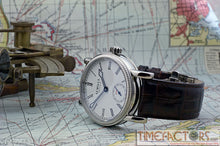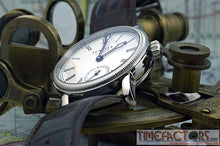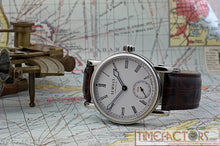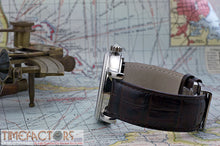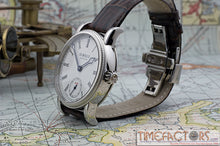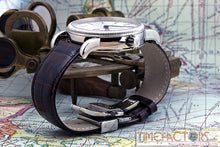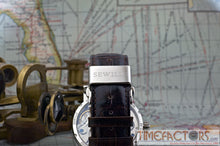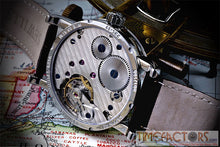
USA Customers please note Tariff advice in our Latest News Section.
Time Factors is proud to announce the launch of the first new watch to bear the Sewills name in 15 years. The Sewills "Ferreira" has been more than two years in the design, manufacture and movement modification to produce a watch of the highest quality.
The Portuguese shipping company Joaquim Antunes Ferreira purchased the clipper from Jock Willis in 1895 for £1250 and renamed it “Ferreira” after the name of the company. The ship was known by the crew as “Pequena camisola”, meaning “little shirt” which was a straight translation from the Scottish “Cutty Sark”.
The “Cutty Sark” was commissioned by shipping magnate John “Jock” Willis and the contract for construction was signed on 1 February 1869 with shipbuilding company Scott and Linton from Dumbarton. The price was £17 per ton up to a maximum weight of 950 tons. The ship was designed by Hercules Linton, who was only 32 years old when he designed the clipper.
Despite running out of money during the construction, additional funds were raised and the “Cutty Sark” was launched on 22nd November 1869.
The ship was named after Cutty-sark, the nickname of the witch Nannie Dee in Robert Burns' 1791 poem Tam o' Shanter. The ship's figurehead, the original carved by Robert Hellyer of Blackwall, is a stark white carving of a bare-breasted Nannie Dee with long black hair holding a grey horse's tail in her hand. In the poem she wore a linen sark (Scots: a short chemise or undergarment), that she had been given as a child, which explains why it was cutty, or in other words far too short. The erotic sight of her dancing in such a short undergarment caused Tam to cry out "Weel done, Cutty-sark", which subsequently became a well known catchphrase. Originally, carvings by Hellyer of the other scantily clad witches followed behind the figurehead along the bow, but these were removed by Willis in deference to 'good taste'.
The ship traded various cargoes between Portugal, Rio de Janeiro, New Orleans, Mozambique, Angola, and Britain. In May 1916 she was dismasted off the Cape of Good Hope because of the rolling of the ship in bad weather and had to be towed into Table Bay off Cape Town. Because of World War I, it was impossible to obtain suitable materials to replace the masts so she was re-rigged over 18 months to a barquentine sail arrangement.
In 1922 Ferreira was the last clipper operating anywhere in the world. Caught in a storm in the English Channel she put into Falmouth harbour where she was spotted by retired windjammer captain Wilfred Dowman, of Trevissome House, Flushing, Cornwall, who was then operating the training ship Lady of Avenel. The ship returned to Lisbon, where she was sold to new owners and renamed Maria do Amparo. However, Dowman persevered in his determination to buy the ship, which he did for £3,750 and she was returned to Falmouth harbour. The rigging was restored to an approximation of the original arrangement and the ship was used as a cadet training ship. As a historic survivor, the ship was opened to the public and visitors would be rowed out to inspect her. Dowman died in 1936 and the ship was sold to the Incorporated Thames Nautical Training College, HMS Worcester at Greenhithe, leaving Falmouth for her last journey under sail in 1938. The ship was crewed by cadets, 15-year-old Robert Wyld steering the ship during the voyage.[26] Ian Bryce, DSC, the last surviving crew member on the historic journey from Falmouth to the Thames died, aged 89, on 11 December 2011.
The Ferreira’s Sewills ship’s chronometer, registered number 4608, is now in The National Maritime Museum.
This is a limited edition of just 100 pieces and because of the time taken to modify the movements, it is unlikely that this watch will ever be available again. The Sewills Ferreira is guaranteed for two years and will be supplied in a "piano black" gloss lacquered wooden box.
CASE
• 316L stainless steel, polished
• Diameter 42mm, 46mm across including crown
• Lug to lug height 52mm
• Thickness 10.75mm to the top of the flat crystal
• Lug spacing 22mm
• Anti-magnetic 4800 A/m
• Water resistance 100m
• Weight 95 grammes with strap and clasp
• Sapphire view back, decorated movement
DIAL
• White
• Luminous: none
HANDS
• Custom blued hands
• Luminous: none
CRYSTAL
• Flat sapphire front & back
MOVEMENT
• Unitas 6498 hand-winding movement extensively modified with screwed Glucydur balance with Nivarox hairspring, swan-neck regulator, 3/4 top plate with Geneva stripes, anglage and blued screws
• Swiss Made
STRAP
• Alligator grain calf leather strap with signed deployant clasp
Country of Origin
Case & Bracelet: Germany
Movement: Switzerland









